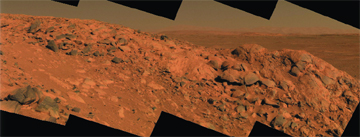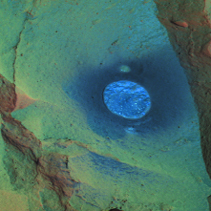 Over
the past nine months, Mars’ twin rovers have delivered amazing photographs
and data to Earth, and now the first published science findings have appeared,
in the Aug. 6 Science. Meanwhile, Spirit and its twin Opportunity continue
to roll across the planet’s surface, sending more information about their
surroundings daily.
Over
the past nine months, Mars’ twin rovers have delivered amazing photographs
and data to Earth, and now the first published science findings have appeared,
in the Aug. 6 Science. Meanwhile, Spirit and its twin Opportunity continue
to roll across the planet’s surface, sending more information about their
surroundings daily.The Spirit rover snapped this panorama of rocks perched above the Gusev Crater plain on Mars on Aug. 5. Scientists are now publishing results from the roverís first 60 days of exploration. Image courtesy of NASA/JPL/Cornell.
Spirit’s home crater Gusev has what looks like a water-carved valley flowing into it. Hoping for further evidence of water, the robot’s handlers gently nudged it off its landing pad and set its machinery in motion last January.
“We went to test a lake hypothesis — we were hoping to find sedimentary rocks, and what we found instead was igneous rocks,” says Steve Squyres of Cornell University in Ithaca, N.Y., who is the lead investigator for the science instruments on both rovers. The crater held what Squyres describes as “shattered” volcanic rocks that had been sitting around for millions of years, broken up by impacts. The sediments the team hoped to find were probably buried by lavas, he says.
Spirit moved on to take pictures of the impact-laden surface. The rover’s miniature thermal emission spectrometer cut through the planet’s atmosphere to show a diurnally flip-flopping temperature curve, 4 kilometers high. As day turns to night, the planet’s surface chills, dropping from about 245 degrees to 190 degrees Kelvin (28 to 83 below 0 degrees Celsius), according to data published in one of 11 Science articles covering the rover’s first 60 days of exploration, co-authored by Squyres and other team members. Spirit experimented with the soil and rocks, finding that the volcanic basalts at the Gusev site contain fractures and vugs (tiny holes), as well as olivine and pyroxene. And two-toned rocks that Spirit observed may hold another possible indicator of water: from evaporated salts that cement fine dust to the rocks’ lower, lighter-colored halves, where they may have been buried in soil.
 But in Spirit’s
first two months of travel, it found evidence of only trace amounts of water.
The rover left its crater, detoured a bit and then “sprinted” to the
Columbia Hills, Squyres says, more than 2 kilometers away from its initial landing
site. Several months past the robot’s expected 90-day lifetime, it is now
in a vastly different landscape.
But in Spirit’s
first two months of travel, it found evidence of only trace amounts of water.
The rover left its crater, detoured a bit and then “sprinted” to the
Columbia Hills, Squyres says, more than 2 kilometers away from its initial landing
site. Several months past the robot’s expected 90-day lifetime, it is now
in a vastly different landscape.This false-color image shows how the Mars rover Spirit used its rock abrasion tool to drill into a rock on the 60th day of its mission. The newly exposed fresh rock was then ready for experiments by the rover’s other instruments. Image courtesy of NASA/JPL/Cornell.
Over just a few meters, as Spirit moved from the plains into the hills, “we crossed into totally different materials,” Squyres says. The plains were covered by only one kind of rock, but in the hills, “no two rocks have looked the same really since we got there,” indicating an extremely complex history. The several-billion-year-old rocks are heavily altered and “munched up,” he says. “It’s really a challenge to unravel the geology here.” But the team is starting to see evidence that some of the changes may be from water, which Squyres hopes to confirm this fall.
Halfway around the planet, the rover Opportunity found evidence of water almost immediately. Within days, as heavily reported by the press, it had sighted tiny “blueberries,” or hematite spheres, embedded in fine layers in the Meridiani crater that indicated a possible shallow lake or saturated rock layer where such concretions could form. Further evidence in the form of iron sulfate hydrate, or jarosite, made scientists on the rover team think of evaporite deposits like Earth’s, and some of the fine-grained, cross-laminated layering evoked shallow, windblown water deposits.
“We landed right next to this wonderful Rosetta stone for Mars, this salty-rich deposit that tells us there was a lot of water there,” says Jim Bell of Cornell University, who is the science team’s leader for the rovers’ cameras and co-author on several of the new Science papers. Bell notes that the two very different sites are representative of other places on Mars. “These small places were very well-chosen,” he says. “Once we understand the details from past missions, then we can understand the places where we don’t have rovers on the ground,” but which have been observed remotely by the Mars Orbiter and other past missions.
Now almost 700 meters away from its landing site, Opportunity is “producing the first stratigraphic section on another planet,” Squyres says, climbing its way down a steep sandy slope and taking samples and observations as it goes. If nothing breaks outright, Bell says, Spirit and Opportunity could last another year, continuing their exploration.
In the meantime, far above the planet, the European Space Agency’s Mars Express is in orbit, taking spectroscopic images that show the possible presence of methane on Mars, and NASA extended the Mars Odyssey orbiter mission to 2006. NASA is also continuing to plan for the next generation of rovers to visit the planet, “with more mobility and a highly sophisticated chemical analysis laboratory onboard,” Bell says. As the rovers’ observations continue moving into the literature, the geologic debates over Mars’ past will likely broaden.

